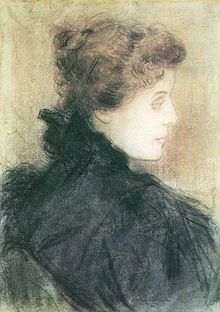Tivadar Andrássy
Count Tivadar (dt. Theodor) Andrássy de Csíkszentkirály et Krasznahorka (born July 10, 1857 in Paris , France , † May 13, 1905 in Budapest , Austria-Hungary ) was a Hungarian politician , member of the Hungarian Reichstag , painter and member of the Hungarian Academy of Sciences .
Life
Tivadar Andrássy de Csíkszentkirály et Krasznahorka was the eldest son of Count Gyula Andrássy de Csíkszentkirály et Krasznahorka and his wife Katalin Kendeffy de Malomvíz (* 1830, † 1896). The father was a Hungarian statesman who was Prime Minister of the Kingdom of Hungary (1867–1871) and Foreign Minister of Austria-Hungary (1871–1879). According to the parents' wishes, the child was to be born in Hungary, but the father was still in exile in France at that time because of his involvement in the Hungarian Revolution of 1848/1849 .
By using his grandmother Etelka Szapáry (* 1798, † 1876), the father was pardoned by Emperor Franz Joseph I and so the family was allowed to return to Hungary in 1860. After the family returned home, Tivadar received his education and schooling in Vienna and Budapest. He took part in the occupation of Bosnia and Herzegovina in 1878 as an officer in a Württemberg hussar regiment .
In 1881 Tivadar was elected a member of the Hungarian Diet for the Tőketerebes district. In 1890 and 1896 he was deputy chairman of the lower house in the Hungarian Reichstag. During this time he was appointed privy councilor by Emperor Franz Joseph I. He was a member of the Hungarian Academy of Sciences and the Hungarian National Museum .
Tivadar's sister, Ilona (* 1858, † 1952) was married to Count Lajos Batthyány (* 1860, † 1951), the governor of Fiume . The younger brother, Gyula Andrássy d. J. , was a politician and between 1906 and 1910 Minister of the Interior of the Kingdom of Hungary and the last Foreign Minister of Austria-Hungary .
Tivadar was an avid art collector, he was also known as a painter, especially he was engaged in naturalistic landscape painting. In Tőketerebes he financially supported the arts. From 1890 he was president of the Hungarian Academy of Fine Arts . In 1907, two years after his death, 80 of his works were shown in a special exhibition and presented to the public.
Tivadar Andrássy made a great contribution to the beautification of his estate in Tőketerebes between 1890 and 1904 . He appointed the landscape architect Louis Flament who laid out a ' French garden ' and refined the near-natural English landscape park .
Tivadar Andrássy was politically active all his life. He was a member of the Liberal Party (Hungarian Szabadelvű Part ). During a campaign trip in the winter of 1905 he drove in an open car to Gálszécs and Kosice to be successful in the upcoming parliamentary elections. During this trip he caught a bad cold that culminated in pneumonia . His doctors recommended a stay on the Adriatic Sea in what was then southern Hungary. During the trip there, his health deteriorated very quickly, so he had to interrupt the trip in Budapest. He died in his Budapest palace on May 13, 1905. His remains were transferred to Tőketerebes and buried in the Andrássy mausoleum there on May 15, 1905.
After Tivadar Andrássy's death, his estates passed into the possession of his younger brother Gyula Andrássy the Elder by inheritance. J. about.
progeny
He had four daughters with Countess Eleonora Maria Rudolphine Zichy de Zich et Vásonkeö (born March 28, 1867 in Budapest, † January 31, 1945 ibid.), Whom he married on June 24, 1885:
- Ilona (born May 22, 1886 in Tőketerebes , Austria-Hungary , † August 21, 1967 in Peterborough , Canada )
- Borbála (born January 9, 1890 in Budapest , Austria-Hungary , † August 18, 1968 in Montreal , Canada )
- Katalin (born September 21, 1892 in Tiszadob , † 12 June 1985 Antibes , France) was, with Mihály Károlyi married
- Klar a (born January 18, 1898 in Budapest , Kingdom of Hungary , † April 12, 1941 in Dubrovnik , Kingdom of Yugoslavia )

After the death of Tivadar Andrássy, his widow Eleonora Zichy married her brother-in-law, Gyula Andrássy the Elder, in 1909. J., who became the foster father of her four daughters and at the same time he was also the legal guardian .
Web links
- Tivadar Andrássy, biography (Slovak)
- Memorial exhibition of Andrássy's pictures 1907 (Hungarian)
- Short biography (Hungarian)
References and comments
- ↑ Tivadar had three younger siblings: Ilona (* 1858, † 1952), Gyula d. J. (* 1860, † 1929) and Manó (Emanuel).
- ↑ Etelka Szapáry was a canon at the Star Cross Order and maintained good relations with Empress Elisabeth .
- ↑ Tivadar Andrássy had the mausoleum between 1891 and 1893 for his late father Gyula Andrássy the Elder. Ä. erect. This is a neo-Gothic building, which was planned by the German architect Arthur Meinig .
- ↑ Katharina (Hungarian Katalin) was referred to as "the red countess" because she married Mihály Károlyi (* 1875, † 1955) the prime minister of the " aster revolution ".
| personal data | |
|---|---|
| SURNAME | Andrássy, Tivadar |
| ALTERNATIVE NAMES | Andrássy de Csíkszentkirály et Krasznahorka, Tivadar Count |
| BRIEF DESCRIPTION | Hungarian politician, member of the Hungarian Reichstag, painter |
| DATE OF BIRTH | July 10, 1857 |
| PLACE OF BIRTH | Paris , France |
| DATE OF DEATH | May 13, 1905 |
| Place of death | Budapest , Austria-Hungary |
